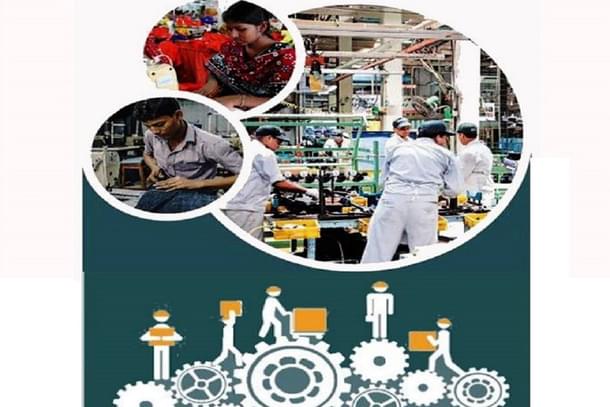Economy
Finance Crunch Threatens To Spoil MSME Party: Here's How To Save It
Pratim Ranjan Bose
Jul 04, 2023, 12:16 PM | Updated 12:17 PM IST
Save & read from anywhere!
Bookmark stories for easy access on any device or the Swarajya app.


Nine years of unprecedented infrastructure building and a policy focus on domestic manufacturing have brought many welcome changes in the Indian economy.
The most critical of them is the return of the core sector to prominence. As of 2023, almost all industries of the core sector are in expansion mode, creating a huge value chain impact.
The micro, small and medium enterprises (MSME), catering the core sector, are witnessing an unprecedented rush of orders. The order flow increased from the second half of last year. This year it came in a wave.
On the flip side although, the dramatic change in fortunes has exposed serious scalability concerns at the MSME level, primarily due to the limited flow of finance.
India created provisions for easy finance to the MSME sector. However, it's proving too little for too many. The majority of MSME lending is fully collateral backed or is available at high interest.
The obstructions to the scalability of small industries makes them vulnerable to supply chain bottlenecks. Parts of it are already visible. Prices have firmed up and many MSMEs are avoiding taking fresh orders due to capacity constraints.
The problem is still in its early phase though. An urgent intervention may help the country avoid the unfortunate consequences like opening doors to imports and suffering another round of ‘jobless growth.’
Orders Galore, Not Finance
Probal Roy Choudhury’s Fluid Control and Engineering Company at India’s oldest fabrication hub in Howrah, near Kolkata, in West Bengal, is keen to tap this opportunity.
An M-tech from the Indian Institute of Technology, Probal makes components for material handling equipment. The unit was set up by his father in 1987. Inflationary impact on turnover apart, the business outlook remained static for the next three decades.
Winds of change started blowing from the end of 2022-23 (FY23). Probal ended the last fiscal with a turnover of over Rs 5 crore, thereby elevating the status of the company from micro (upto Rs 5 crore turnover) to small (Rs 5 to 50 crore).
Since then, life is moving in the express lane. Fluid Control’s order book grew by two-fold in FY24. Prices are firm. Probal needed an equivalent increase in working capital. The banker extended the credit limit at 50 percent collateral support.
Orders are the least of Probal’s worries at this juncture. “With large industries going for capacity expansion, the upcycle should continue for some time. However, with most of my assets already pledged, I may not have much headroom to grow beyond FY24,” he said.
Atish Agarwal of A J Cast Alloys, also in Howrah, has already hit the finance wall. His company melts scraps to produce tailor-made cast iron products required for fabrication.
From Rs 8 crore before Covid, his turnover increased to Rs 13.5 crore in FY23. Going by the order book position, the business should grow by a minimum of 50 per cent this year.
Margins have improved substantially. In a major development, buyers (like Probal) are even offering booking advances. Atish is now in a hurry to expand the business.
He has Rs 3.5 crore credit limit from HDFC Bank. He wanted the limit to be extended by another Rs 50 lakh but the banker didn’t oblige. ICICI Bank offered the loan but at 1.5 per cent higher rate.
Atish decided against sacrificing margins for turnover. He didn’t avail of the high-cost loan.
CGTMSE And SIDBI
Both Probal and Atish have strong backgrounds and balance sheets. The reception they get from banks is above average. The majority MSMEs are not even half as blessed and get loans at inferior terms.
The problem has many facets.
First, as a thumb rule, commercial banks are less keen to serve smaller initiatives, which need capital the most and have less collateral to pledge.
To break the deadlock, the government and the Small Industries Development Bank of India (SIDBI) jointly created the Credit Guarantee Fund Trust for Micro and Small Enterprises (CGTMSE).
According to the CGTMSE website, it extends as much as 85 per cent guarantee against loans of up to Rs 5 crore offered by banks. As in FY23, the trust approved guarantees worth Rs 1 lakh crore.
However, this is too little when compared to the huge MSME population.
According to National Sample Survey 2015-16, India has 633 lakh such units. At an average of Rs 50,000, the sector needs Rs 3.16 lakh crore of credit, three times the guarantee offered by CGTMSE.
According to Udyam Registration portal, there are over two crore MSMEs in the country, of which 5.55 lakh are small. At Rs 1 crore per unit, only the small enterprises will require a total of Rs 5.55 lakh crore credit, five times the size of guarantees.
Clearly, the institutional mechanism is insufficient.
The solution lies in enhancing the CGTMSE guarantees by five to 10 times. SIDBI may also consider increasing the cap of guarantees. Targeted guarantees for the core sector MSME lending may also be considered.
That’s not all. SIDBI offers refinance to banks and non-banking financial institutions for lending to MSMEs. Subhendu Moitra of Coeus Advisors points out that refinance is critical in a tight liquidity scenario.
With the lowest gross non-performing assets (NPA) of the decade, Indian banks are now flushed with cash. If they are still not advancing easy finance to MSMEs, it's either due to a lack of attention or skill.
SIDBI may instead consider direct lending to the MSME to disrupt the credit market. The National Bank for Agriculture and Rural Development (NABARD) is doing that in the farm sector through its subsidiary Nabkishan Finance.
States Must Chip In
The introduction of goods and services tax and the spread of cashless payment infrastructure have paved the way for the fast-paced formalisation of Indian business over the last decade.
The benefits have touched the MSME sector as well, which should improve their ability to access finance. The BSE SME (small and medium enterprises) platform has opened new opportunities to raise finance.
However, it would take time before the platform becomes popular with investors. Also, for smaller companies, the issue cost would be significantly high. Until such time, more government attention is required in this area.
MSMEs employ 11-12 crore people and states are the biggest beneficiaries. However,when it comes to supporting the sector, states are barely active. This must change.





